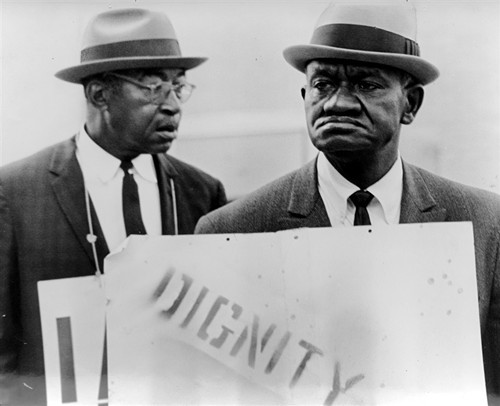
- Louis Goggans
- Richard Copley
April 4th, 1968, forever remains a date embedded in history: the day Dr. Martin Luther King, Jr. was assassinated.
The tragic occurrence took place during Dr. King’s visit to Memphis to support a strike of 1,300 sanitation workers, who demanded to be treated equally to and receive the same wages as their white colleagues.
Award-winning photographer Richard Copley was privileged to experience and capture some of the strike’s most intense moments—along with the aftermath of King’s assassination—and subsequent settlement between sanitation workers and the City of Memphis.
People have the chance to travel through time and envision what it was like during late March and early April of 1968 by visiting Copley’s “I Am a Man” exhibit inside of the Benjamin L. Hooks Central Library. The exhibit features 13 images and is free to the public.
“I want [visitors] to take away the fact that history is what we are,” Copley said. “We may not like the history in some instances, but history is a very important part of our fabric. It’s what makes us, and it is also what makes us better. I think, especially young folks, need to see these images to know that there was a struggle and the struggle was overcome.”
The exhibit is titled after Copley’s most successful image, which displays a swarm of men holding white picket signs with the statement “I Am a Man” emblazoned across them in black lettering.
A 22-year-old Memphis State journalism student at the time, Copley said he never thought the image he took on March 28th, 1968 would become such an iconic photo that helped catapult his career as a photographer and remains cherished 46 years later.
“I didn’t have a clue,” Copley said. “Who would have had a clue? I knew it was a good picture, but I didn’t know it would take on the role that it has taken on.”
Copley had the chance to take the historical pictures while doing freelance work for the American Federation of State, County, and Municipal Employees (AFSCME) union.
Other images in the exhibit include Dr. King’s “Mountain Top” speech at Mason Temple, the Sanitation Workers Strike march, National Guard troops armed with machine guns and riding in tanks, Dr. King’s memorial march led by Coretta Scott King, and the Sanitation Workers Strike settlement with the City of Memphis.

- Richard Copley
Although Copley, a white man, was immersed in a crowd predominantly filled with African-Americans upset by the treatment they received by some white people, he said the only time he felt threatened was during the sanitation strike march. The Dr. King-led event came to an abrupt end after some participants clashed with law enforcement.
Copley managed to capture an image of Dr. King with a concerned expression on his face minutes before he was pulled out of the march and placed into a car. Shortly after, a riot ensued leaving numerous people hurt, shops looted, and a 16-year-old fatally shot by police.
“Back behind [the march], you could hear glass breaking, hollering, and screaming,” Copley recalled. “[King] was escorted out of the march. Right after that, all hell broke loose. I got pepper-sprayed. It was ugly. While I was disabled, I could hear people screaming and getting hit. It was pretty terrifying.”
Despite the “I Am a Man” photo being the most popular image in the exhibit, Copley’s personal favorite is titled “Dignity.” The image showcases the Rev. Theodore Hibbler and Ted Brown, both sanitation workers, holding posters, one of which has the word “Dignity” stenciled across it.
“I saw their stern faces and their Sunday go-to-meeting best with their hats,” Copley said. “The sign and the word ‘Dignity’ stenciled … For me, this is my favorite image, because of what it says and the look on their faces. They’re just trying to make a statement. They finally did get dignity in the end, at a greater cost. It was no real monetary gain, but it was a lot of humanity and moral gain from this.”
Follow me on Twitter: @Lou4President
Friend me on Facebook: Louis Goggans
Check out my website: ahumblesoul.com
